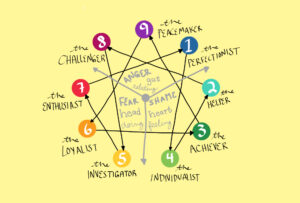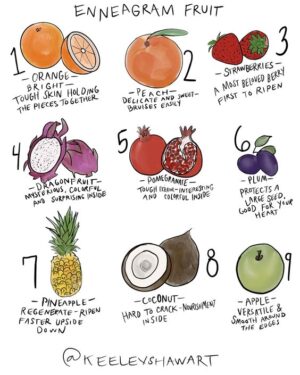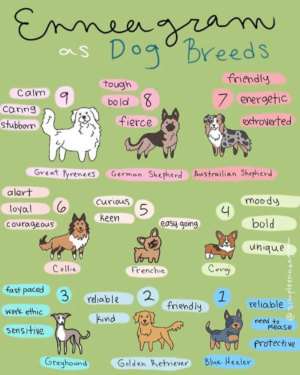As a Personality-Focused Psychotherapist, I use a number of Psychology Models or Systems in my work. One of my favourites is the Enneagram Model.
How Does The Model Work?
 The “Enneagram of Personality” details nine personality descriptions or categories and the interconnections among them. Each of the nine personality “types,” or “styles,” represents a distinct way of operating in the world based on a specific “focus of attention”: what you pay attention to and what you don’t pay attention to.
The “Enneagram of Personality” details nine personality descriptions or categories and the interconnections among them. Each of the nine personality “types,” or “styles,” represents a distinct way of operating in the world based on a specific “focus of attention”: what you pay attention to and what you don’t pay attention to.
For instance, what do you typically pay attention to when you first wake up in the morning? Different people with different personality types tend to start the day with different moods and different thoughts. Some types wake up angry, some immediately start thinking about their mental list of “things to do,” and others feel happy and excited at the possibilities of the new day.
This idea that different people pay attention to different things in different ways plays a central role in defining the distinct Enneagram styles. The nine styles or types can be differentiated in terms of their focus of attention or “perceptual bias”—what occupies the central place in what they think about, see, and prioritise in their experience.
To determine a person’s Enneagram style, you might ask yourself the question: What is on your “view screen” (i.e. mind) and what isn’t? This is both the method for figuring out what your main Enneagram type is and a key strength of the Enneagram as a personality model: it highlights how individuals differ in specific ways and it shows how the nine types differ on several levels. It shows what they think about (and don’t think about), what emotions they tend to feel (and not feel), what behaviours are typical of their style, and what actions they rarely take.
For example, a group of people could enter into the same situation—say a birthday party—and they might all focus on different aspects of the gathering, depending on what their personality programming directs them to pay attention to. One person might focus on finding particular people they know, another person might be drawn to the food table, someone else might worry that they forgot to bring the host a gift, and yet another person might gravitate toward whomever seems to be having the most fun. The Enneagram thus reveals a basic truth that often surprises people: other people don’t all view the world the way we do; different people can look at the same situation and see completely different things.
Each of the Enneagram’s nine types’ of specific focus of attention grows out of a central “coping strategy”—the go-to method for getting around, adapting to the environment, and surviving in the world. This primary coping strategy and attentional bias gives rise to a matching worldview and corresponding habitual patterns of thought, emotion, and behaviour. At its core, each of these nine personality styles is basically a “defensive” structure—an inner program that operates automatically to protect us from being hurt or feeling uncomfortable. In addition, the patterns that make up the personality also represent our particular strengths, specialties, and super powers.
 Oriented around a nine-pointed figure (“ennea” meaning nine and “gram” meaning something drawn) that serves as a graphic framework for these nine personalities, the Enneagram helps solve much of the mystery behind why different people see the world in totally different ways. (And no, this isn’t some sort of sinister sign or cultish emblem!—it’s a perfectly innocent nine-pointed star inscribed in a circle that is also intended to convey a symbolic meaning about the way natural processes get created and unfold in particular patterns or sequences.)
Oriented around a nine-pointed figure (“ennea” meaning nine and “gram” meaning something drawn) that serves as a graphic framework for these nine personalities, the Enneagram helps solve much of the mystery behind why different people see the world in totally different ways. (And no, this isn’t some sort of sinister sign or cultish emblem!—it’s a perfectly innocent nine-pointed star inscribed in a circle that is also intended to convey a symbolic meaning about the way natural processes get created and unfold in particular patterns or sequences.)
This model, which stretches back into antiquity, as well as more recent roots in modern psychology borrows some of its central understanding both from psychoanalytic/psychodynamic models and Object Relations theory, but also from Attachment and Trauma theory, Developmental Neurobiology, and a host of other creative interfaces which have enriched the model in its last 50 years of active use in both business, coaching, psychotherapy, as well as multi-faith spiritual communities.
Each of the nine personality styles can be identified by its distinct adaptive strategy, and matching strengths, habits, challenges, and blind spots that grow out of whatever strategic way they have adopted to get what they need in life.
We Are “Three-Brained” Beings: The Enneagram’s Three “Centres of Intelligence”
 The nine types, or styles, come grouped in three sets of three, according to three “centres of intelligence”—the idea that we humans process information from the outside through three modes, or forms, of intelligence. The easiest way to begin to understand the content of the Enneagram system’s nine personality types is to see how (and why) these nine types are grouped into three buckets of three types each.
The nine types, or styles, come grouped in three sets of three, according to three “centres of intelligence”—the idea that we humans process information from the outside through three modes, or forms, of intelligence. The easiest way to begin to understand the content of the Enneagram system’s nine personality types is to see how (and why) these nine types are grouped into three buckets of three types each.
According to the Enneagram map, every person has not one, but three “brains” or “centres of intelligence”: the head, the heart, and the body. The head is the centres of thinking and analyzing, the heart is the centre of feeling emotions and relating to others through empathy, and the body is the centre of sensing things physically, through “gut knowing” and instinctive responses. The body also houses the “movement” centre, which directs action or inaction.
Although we all use all three of these centres all the time, three of the nine Enneagram styles (8, 9, and 1) “live in” or “overuse” the body centre, three of the styles (2, 3, and 4) operate primarily from the heart center, and three of the styles (5, 6, and 7) are based in or biased toward the head centre. These three “centres of intelligence” also have a direct relationship to the three parts of the human brain: the brain stem and amygdala (the reptilian or instinctual brain), the limbic (or emotional) brain, and the neo-cortex (the mental brain). We all call upon all three brain functions all the time, but one of these centres plays a dominant role in the expression of our personality.
In this way, the Enneagram model embodies the idea that while we all have the potential for “wholeness,” that is, we all potentially have access to all nine strategies for making our way in the world, we tend to get “out of balance” by learning to rely on one mode of relating to the world more than others. Working with the Enneagram involves noticing how we tend to be biased toward one centre of intelligence over the others and intentionally trying to achieve a more conscious balance among the three modes of functioning.
In fact, the whole point of the Enneagram is about growth and balance—by seeing how we resort to one point of focus among nine possibilities, we can begin to see how we fixate on a narrow slice of 360 degrees of reality and learn to expand our perspective.
Each of the nine types describes a set of habitual ways of thinking, feeling, and acting, based on a specific view of what strategy works best for getting what you need. For instance, there’s one type (Type Five) that automatically assumes it’s best to focus on gaining knowledge and protecting boundaries to find the sense of safety they need. So they prioritize thinking above feeling and maintaining a strong sense of privacy. Fives have the most introverted style of relating, which underscores their view that to feel safe they need to guard their inner resources. Another type (Type Nine) believes that the best strategy to gain the sense of well-being they need is to be in harmony with other people. So, Nines tend to be preoccupied with maintaining peaceful relations with others, “going along to get along,” and mediating among different points of view to create harmony and consensus. Still another kind of personality (Type Three) focuses like a laser beam on goals and tasks as a way of achieving success and looking good in the eyes of others to get the approval and admiration they need.
All of these personality styles have strengths and corresponding challenges—an upside and a downside. As the different Enneagram styles show, when we approach the world through a specific lens or filter, it allows us to develop particular areas of clarity and strength based on becoming a specialist at what that lens brings most into focus. However, on the downside, each style can overfocus on a relatively narrow set of strengths, such that they overdo those strengths to the point where they become liabilities. Unconsciously focusing too much of your attention on too narrow a set of strengths can cause you to develop and maintain certain blind spots.
This is where the Enneagram is invaluable—it shows us how, in leaning into our most developed capacities, we develop blind spots when it comes to other abilities. The Enneagram highlights our strengths, so we can appreciate and mobilize our assets, and it helps us see our weak points, so we can work to grow aspects of ourselves that we have neglected or overlooked or avoided.
For instance, when I learned my Enneagram type (Type Four), I realized that while I was good at making friends, being generally likable, and supporting others, I continually avoided conflicts (fearing that such problems would cause people to dislike me) and often focused on other people’s needs and feelings (as a strategy for being liked) at the expense of my own. This caused problems in my relationships when the needs and feelings I avoided being aware of caused me to be resentful when people didn’t give me what I needed. The Enneagram helped me see the problem in my basic life strategy: by trying to get along with people by not burdening them with my needs, and then getting mad when they didn’t read my mind and respond to the needs I hadn’t expressed, I ended up driving people away and ensuring the rejection I was trying to avoid in the first place!
Every person can benefit through learning the strengths and blind spots associated with their personality style. For instance, Type Eights are very good at asserting themselves in a strong way, confronting people with hard truths, and holding their ground in a conflict. But they have a blind spot when it comes to the value of being vulnerable or understanding their weak points: they tend to be out of touch with their more vulnerable feelings, which can lead them to overcompensate for the unconscious fear of being weak through expressing too much strength. Seeing this blind spot around vulnerability and consciously getting in touch with their softer feelings balances Eights out, so they can be both strong and approachable, powerful and empathetic.
As another example, Type Sixes make excellent troubleshooters, as they are great at seeing what can go wrong ahead of time and preparing to fix it, but they have a blind spot around the impact and consequences of always looking for trouble. Type Sixes often don’t see that they can become overly “problem-seeking” instead of constructively solution-focused, can appear paranoid, and can get caught in “analysis-paralysis,” when their fear of potential threats causes them to avoid taking action. Sixes can be more effective and easier to work with when they consciously take account of the blind spot around their fear and its effects and blend their talent for careful analysis with bold action.
 What Number Are You? A Brief Sketch of the Enneagram’s Nine Personality Styles
What Number Are You? A Brief Sketch of the Enneagram’s Nine Personality Styles
I first became fascinated with the Enneagram when I learned that I was a Type Four a few years ago. Most people want to know more about why they do the things they do, and when I read a description of my type, it was a profound revelation. I felt shocked and surprised that any personality typology could paint such a clear, straightforward, and accurate picture of how I operate in the world: both in terms of what I knew to be true about myself and (embarrassing) aspects of myself I didn’t really want to admit to.
Learning about my personality style as mapped out by the Enneagram changed my life. It helped me see things about myself I hadn’t wanted to see before—things that created obstacles in my life because I didn’t want to acknowledge them. For example, as a Type Four, I would (and still often do) spend a lot of time having conversations in my head about the wrongs or losses I had experienced in the past, resenting and feeling angry about ways in which I had been treated. But when I came to see why I, as a Type Four, became emotional, and understood the reasons behind my sensitivity, I could more easily value (or at least better tolerate) my emotional nature, recognise the strength in it, have a wee bit more compassion for myself, and start doing the hard (and not always successful) work of keeping my reactive temperament in check. Especially with regard to family and romantic relationships. The Enneagram helped me see—in a gentle way—that sometimes I was oversensitive and overly emotional. But it also helped me see that I could both value my emotional capacity and empathic ability and consciously rein in some related tendencies to be more effective and happy in my life and work. Learning about myself through the Enneagram has made me much happier, much easier to be around, and hopefully a better future partner.
 Here is a brief sketch of the Enneagram’s nine types. It may take a bit of study to find your correct type, because some of the types can look alike, and we sometimes don’t know ourselves as well as we think we do. However, many people immediately recognise their own style—or the style of people they know—in even the shortest descriptions.
Here is a brief sketch of the Enneagram’s nine types. It may take a bit of study to find your correct type, because some of the types can look alike, and we sometimes don’t know ourselves as well as we think we do. However, many people immediately recognise their own style—or the style of people they know—in even the shortest descriptions.
Click on the Header of each type below for a full description, as well as for examples of what areas might be useful to focus on in therapy with this type of personality style.
Individuals with a Type One style tend to view the world in terms of how it matches (or doesn’t match) what they view as perfect or ideal. They focus attention on whether things are “right or wrong” or “good or bad.” Their central concerns include doing the right thing and/or making sure others do the right thing, noticing and correcting errors, and working hard to improve things. They can be very self-critical and usually conform to the rules.
Individuals with a Type Two style tend to be friendly, upbeat, emotional, and generous (to a fault). They focus their attention on relationships and what other people think and feel about them. A central concern is making other people like them, and they may be giving, helpful, or self-sacrificing to strategically gain others’ approval. They “shape-shift” to present themselves in whatever ways they think will help them create positive rapport with others. They empathise (or overempathise) with others, and they automatically sense the moods, needs, and preferences of the people around them, but may be out of touch with their own feelings and needs.
Individuals with a Type Three style view the world in terms of tasks, goals, image, achievement, and success. They focus their attention on being perceived as successful and getting a lot done. They excel at matching the ideal model of material success and cultural signs of achievement (having a nice car, attaining high status, having impressive credentials). They usually focus on doing at the expense of feeling (emotions) and being. They can be workaholics who have difficulty slowing down and knowing what they are feeling, but they accomplish a great deal in the most efficient way.
Individuals with a Type Four style value authenticity and tend to be comfortable with a wide range of emotions, including pain. They focus their attention on their own internal world, connection and disconnection with others, what’s missing in a given situation, and the aesthetic aspects of their environment. Because they live more in their feelings than other types, they can at times overidentify with their emotions. They value depth and the genuine expression of feeling in relationships. Idealistic and creative, they regularly experience longing and melancholy and may at times be preoccupied with the past.
Individuals with a Type Five style tend to be introverted and shy and less emotionally expressive than other types. They focus their attention on thinking, gaining knowledge, interesting intellectual pursuits, and creating boundaries to maintain privacy. They often have the sense that they have a limited amount of energy and so are sensitive to others potentially draining them of their finite stores of time or resources. Because they value personal space, they may have a hard time sharing themselves with others in relationships.
Individuals with a Type Six style focus attention on detecting threats to their safety and preparing to meet danger or trouble. They tend to be loyal, analytical, contrarian, and suspicious of authority. Naturally vigilant, they can be either actively fearful (phobic) or strong and intimidating as a proactive move against fear (counterphobic). Their natural tendency to assess threats and risks makes them good trouble-shooters, but they can also struggle with paranoia, indecision, and catastrophic or “worst-case scenario” thinking. Most Sixes have authority issues—they both want a good authority and may test or rebel against authority figures.
Individuals with a Type Seven style tend to be energetic, fast-paced, and optimistic. They focus their attention on fun and stimulating things to think about and do, on creating many options, and planning. They are usually enthusiastic, future-oriented, fun-loving people who dislike feeling uncomfortable feelings including sadness, anxiety, boredom, or pain. They are good at reframing negatives into positives, have quick minds, and usually have many interests and enjoy engaging socially with others.
Individuals with a Type Eight style tend to be attuned to strength and power—who has it and how they wield it. They usually have more access to their anger and a higher tolerance for conflict and confrontation than other types. Eights focus their attention on creating order, seeing the big picture, and noticing whether things are fair and just. They are assertive, direct, and strong. They have a large energetic presence, can be intimidating, and may underestimate their impact on others. They can be excessive, impulsive, generous, and protective of others.
Individuals with a Type Nine style make good mediators because they can naturally see all sides of an issue and feel motivated to reduce conflict and create harmony. Affable and easy-going, they “go with the flow,” focusing attention on blending with and over-adapting to others as a way of staying comfortable and avoiding separation and conflict. Because they value harmony and dislike conflict, they tend to be distractible and out of touch with their own anger and personal agenda. The lack of a connection with their own priorities makes it difficult to make decisions, so they often remain on the fence or procrastinate.
Breaking It Down Again: The Additional Information Provided by the 27 Subtypes
 At the risk of overwhelming you completely, I now need to tell you that there is another level to the Enneagram types beyond the nine personality styles.
At the risk of overwhelming you completely, I now need to tell you that there is another level to the Enneagram types beyond the nine personality styles.
Just as the three centres of intelligence (head, heart, and body) “house” three types each, each of the nine types breaks down into three versions again. So, there are actually 27 types, or “sub-types.” This additional level of “sub-types” adds yet another degree of specificity to the personalities we find in the world that the Enneagram describes.9 While adding another layer of types may seem like too much information, the 27 subtypes are crucially important to understand, because the additional, more nuanced information they provide helps with finding your correct type and understanding the nine types with greater clarity.
The three subtypes of the nine main types are defined by which of three “instincts” or “instinctual biases” is dominant. We all have all three animal instincts—for self-preservation, establishing social relationships and positioning in relation to groups, and the instinct for one-to-one bonding—that help us function in the world and keep us safe. And just as each person favours one centre and one type within that centre , we each favour one of these three instincts as kind of a “first line of defence.”
Type Ones
Type Ones focus on making things more perfect, and they do it in three ways:
• Self-Preservation Ones focus on making everything they do more perfect. They are the true perfectionists of the Enneagram. They see themselves as highly flawed and try to improve themselves and make every detail of what they do right. These people are the most anxious and worried Ones, but also the most friendly and warm.
• Social Ones focus on doing things perfectly in a larger sense—knowing the right way to do things—and modeling how to do things right for others. An intellectual type of person, these Ones have a teacher mentality in that they see their role as helping others see what they already know: how to be perfect.
• One-to-One Ones focus on making other people—and society as a whole—more perfect. More reformers than perfectionists, they tend to display more anger and zeal than the other Ones. These Ones focus less attention on perfecting their own behavior and pay more attention to whether others are doing things right.
Type Twos
Type Twos focus on gaining approval and creating positive rapport with others, and they do it in three ways:
• Self-Preservation Twos seek to gain approval through being charming and youthful. Less oriented to giving and more burdened by helping, they charm others into liking them as a way of getting people to take care of them. More self-indulgent, playful, and irresponsible than the other two Twos, they are more fearful and ambivalent about connecting with others.
• Social Twos seek to gain approval from others through being powerful, competent, and influential. More of a powerful, leader type of person, they take charge of things and play to a larger audience as a way of proving their value.
• One-to-One Twos gain approval through being generous and attractive. They emphasize their personal appeal and promises of support to make others like them and do things for them—this is a more emotional, passionate Two.
Type Threes
Type Threes focus on looking good and working hard to get things done and do this in three ways:
• Self-Preservation Threes work hard to assure material security for themselves and the people around them. Oriented to being good (as well as looking good) according to social consensus, they want to appear successful to others, but they don’t want to brag or self-promote in an obvious way (because that wouldn’t be good). SP Threes are self-sufficient, extremely hard-working, results-oriented, and modest.
• Social Threes work hard to look flawless in the eyes of others. Oriented to competing to win and attaining the material and status symbols of success, they focus on getting things done and always having the right image for every social context. Social Threes enjoy being onstage, have a corporate mentality, and know how to climb the social ladder.
• One-to-One Threes focus on creating an image that is appealing to others and supporting and pleasing the people around them—especially partners, coworkers, and family members. They have a relationship or team mentality and can work very hard to support the success of others (rather than their own).
Type Fours
Type Fours focus on expressing themselves creatively and authentically to build meaningful connections, and make themselves understood in three ways:
• Self-Preservation Fours are stoic and strong—emotionally sensitive by nature, they hold their feelings in to prove themselves and connect with others. While they feel things deeply, they often have a sunny, upbeat exterior. They may feel anxious inside, but they tough things out and have a high tolerance for frustration.
• Social Fours focus on their own emotions and the underlying emotional tone of whatever situation they are in. They compare themselves to others and tend to see themselves as less worthy or lacking in some way. They are more emotionally sensitive than most other types and connect to themselves through the authenticity of their emotional truth.
• One-to-One Fours are more assertive and competitive. These Fours are not afraid to ask for what they need or complain when they don’t get it. They can appear aggressive to others, and strive to be the best.
Type Fives
Type Fives focus on attaining knowledge and maintaining boundaries with others to protect their private space and avoid having their energy and inner resources depleted by others. They do this in three ways:
• Self-Preservation Fives focus mainly on maintaining good boundaries with others. Friendly and warm, SP Fives like to have a private space they can withdraw to if they want to be alone.
• Social Fives enjoy becoming experts in the specific subject areas that interest them. They like acquiring knowledge and connecting with others with common intellectual interests and causes.
• One-to-One Fives have more of a need for connecting with other individuals under the right conditions. These Fives are more in touch with their emotions inside, though they may not show it on the outside.
Type Sixes
Type Sixes focus on detecting threats and preparing to meet them. They seek safety and certainty, are slow to trust, try to manage risk, and are sensitive to power dynamics. These traits manifest in three ways:
• Self-Preservation Sixes are the more actively fearful (the phobic or “flight”) Six. They doubt and question things in an effort to find a sense of certainty and safety (that often eludes them). They seek to be warm and friendly to attract allies as a form of outside support or protection in a dangerous world.
• Social Sixes are more intellectual types who find a sense of safety in following the guidelines of a system or way of thinking to feel protected by a kind of impersonal outside authority. They tend to be logical, rational, and concerned with reference points and benchmarks.
• One-to-One Sixes cope with underlying fear (that they may not be aware of) by appearing strong and intimidating to others. Of the “fight” or “flight” reactions to fear, they choose “fight,” and tend to be risk-takers, contrarians, or rebels. They have an inner program that tells them that the best defense is a good offense.
Type Sevens
Type Sevens focus on whatever feels pleasurable and like to think about stimulating ideas and positive visions of the future as a way of unconsciously moving away from whatever might feel uncomfortable or painful. They do this in three ways:
• Self-Preservation Sevens are very practical. Good at getting what they want, they readily recognize opportunities and know how to make things happen, whether through pragmatic planning or a network of allies. They tend to have a talkative, amiable, hedonistic style.
• Social Sevens want to avoid being seen as excessively opportunistic and self-interested, so they focus on sacrificing their immediate desires to pursue an ideal of being of service to others. They take responsibility for the group or family and want to be seen as good by easing others’ suffering.
• One-to-One Sevens are idealistic dreamers, who have a need to imagine something better than what might be true in their everyday reality. Extremely enthusiastic and optimistic, they have a passion for seeing things as they could be or as they imagine them to be (as opposed to how they really are).
Type Eights
Type Eights focus on power, control, justice, and fairness—who has the power, and will they be competent and fair. Assertive and direct, they are good at seeing the big picture and like to exert strength to make things happen. These traits manifest in three ways:
• Self-Preservation Eights focus on getting what they need to survive in a direct, no-nonsense way. They have a low tolerance for frustration and a strong desire for the timely satisfaction of their material needs. They know how to do business and get things done and don’t need to talk about it very much.
• Social Eights focus on protecting and mentoring others they are connected to or anyone they view as needing their support. While they can be rebellious and assertive, they appear less aggressive as they have a softer side when it comes to taking care of others.
• One-to-One Eights have a strong rebellious tendency and like to be the center of things. More provocative and passionate than the other Eights, they like to have power over people and situations.
Type Nines
Type Nines focus on creating harmony and mediating potential conflicts when they arise to maintain a sense of peacefulness and get to consensus. Often out of touch with their own desires or opinions, they like to go with the flow and adapt to others as a way of maintaining positive feelings and avoiding conflict. This happens in three ways:
• Self-Preservation Nines focus on finding comfort in familiar routines and the satisfaction of their physical needs. Whether through eating, sleeping, reading, or doing crossword puzzles, SP Nines tend to lose themselves in whatever activities help them feel grounded and comfortable.
• Social Nines focus on working hard to support the groups they are a part of as a way of seeking a sense of comfort in belonging. Congenial people who like to feel a part of things, Social Nines tend to be lighthearted and fun, and expend a lot of effort in doing what it takes to be admitted to and supportive of the group or community.
• One-to-One Nines tend to merge with the agenda and attitudes of important others in their lives. Sweet, gentle, and less assertive than other types, this relationship-oriented Nine may take on the feelings and opinions of the people they are close to without realizing it.
If you can see how this Enneagram model as a framework for understanding both the complexity and the unifying patterns of our human personalities might be of help to you in dealing with whatever situation has brought you to my site, please feel free to get in touch to discuss the matter further with me.
If you’d like to arrange an initial consultation session to talk more about whatever it is you’re going through, we can organise that via email or telephone (07804197605). Also please feel free to drop me a line if you have any other questions regarding the therapy I offer.
Also, you might want to have a look at my How I Work page, as the Personality Focus described above is only one of five factors I consider to be important for any form of good therapy.
I look forward to hearing from you.
